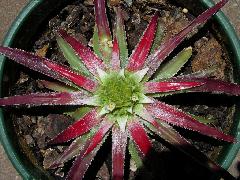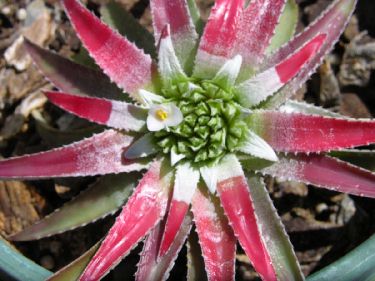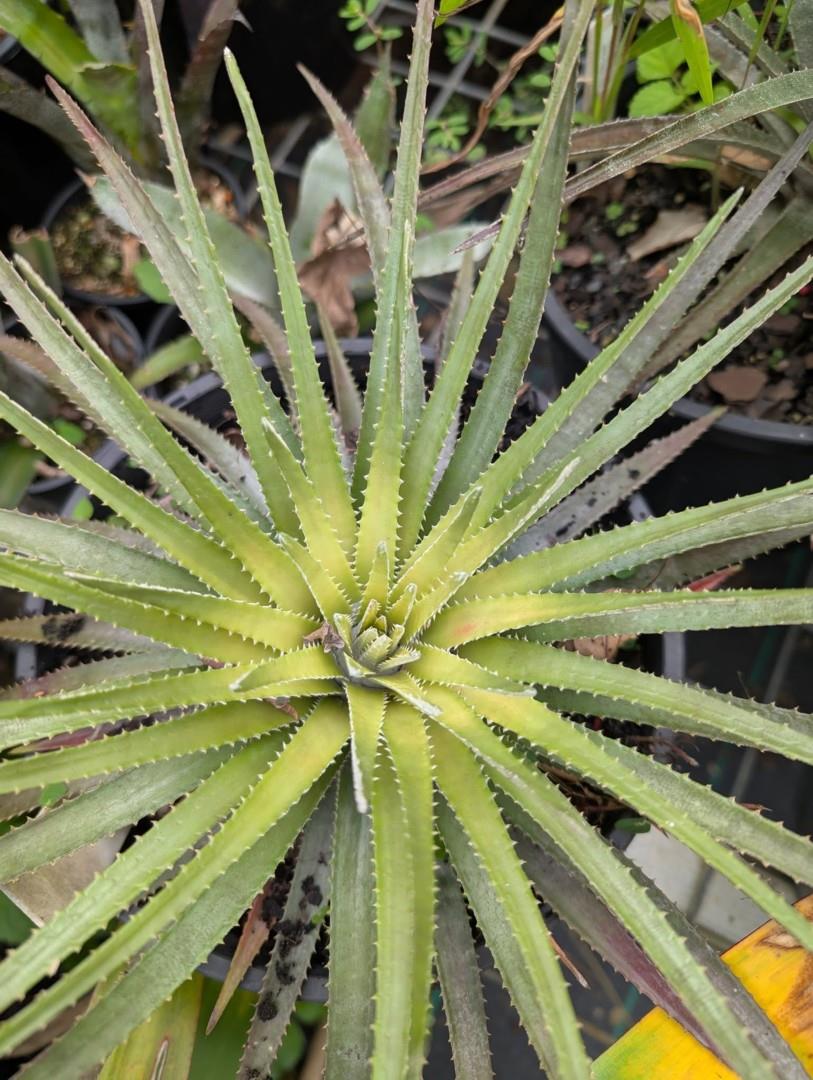


Orthophytum albopictum Philcox in Louzada Thesis 2008 translated by Butcher
Orthophytum albopictum Philcox, Kew Mag. 2:355.1983.
Type: BRASIL. Bahia: Mucuge, Storr 122 (Holotype: CEPEC!; Isotype: K, photo!).
Description:
Herbs rupicolous or terrestrial, middle to large size, propagating by short side shoots;
stem short, l.l-3.0 x 2.5-3.5 cm.
Leaves numerous, patent or slightly arched, suberect when young, 9-26 cm long;
Sheath greenish-yellow, triangular, widened at base, 0.6-3 x 1.1-3.2 cm, glabrous to lepidote on both sides on the top half of the abaxial face, margins spinescent, spines larger towards the tip, 0.2-l mm long;
Blade coriaceous, flat, red to red-purplish in the direction of the tip, linear-triangular to lanceolate, 8-24 x 0.8-2 cm, adaxial face white lanuginous at base, abaxial face grey, margins spinescent, antrorse spines 0.4-1.2 (-2) mm long, tip mucronulate.
Inflorescence sessile, multifloral, compound, branched at the peripheral part, branches with one or two flowers, surrounded by an external halo white lanuginous at the base of the leaves;
Involucral bracts foliaceous, the largest and most external similar to the leaves at flowering the innermost totally green with the tip densely lepidote, deltoid and lanceolate 1.7-3.8 x 1.6-1.7 cm, margins spinescent, tip mucronulate; see drawing.
Floral bracts, subcoriaceous, green, asymmetrical laterally, triangular, ca. 1.5 x 1 cm, lepidote, margins spinescent, mucronulate tip.
Sepals green, asymmetric, carinate, narrowly triangular, 1.2-1.4 x 0.4-0.5 cm, with scales in parts, apical and basal, entire margins, tip mucronulate.
Petals white, linear-spatulate, ca. 1.8 x 0.4 cm, entire margins, tip obtuse, simple trichomes at base;
Petal appendages saciform, lacerated, approx. 6 mm from the base of petal, calluses present with the appendages. Epigynous tube ca. 2 mm long. Stamens of the first whorl adnate to the petals, portion free from the filaments ca. 3 mm long, the second whorl free from the filaments, opposite to the sepals, ca. 9 mm long, anthers ca. 4 mm long.
Ovary trigonous, style ca. 1.3 cm long, numerous ovules.
Fruit and seeds not seen.
Distribution and habitat: BRAZIL.
Bahia: Mucugê and Andarai. Inhabits grassland between 700-1,500 m.s.m., rupicolous or terrestrial and also in the driest places in the vicinity of river rapids.
Phenology: Flowers from October to February with peak flowering in January.
Specimens examined: BRASIL. BAHIA: ANDARAI, 4.v.2002, Loureiro 625 (ALCB). MUCUGE, 21.x.1988, Eggli 1249 (CEPEC); Estrada para Cascavel, 27.iii.1980, Martinelli et al. 6689 (RB); Estrada Mucuge-Andarai, 28.iv.2001, Assis et al. s.n. (ALCB); Guine, s.d., Conceicao 1094 (SP); 29.vi.2002, Conceicao 1097 (SP); Parque Municipal "Projeto Sempre Viva", 7.i.2003, Wanderley & Conceicao 2363 (SP); 7.i.2003, Wanderley & Conceicao 2364 (SP); s.d., Wanderley & Conceicao 2366 (SP); 17.i.2006, Wanderley et al. 2538 (SP); Rio Cumbuca, 4.ii.1974, Harley 15982 (CEPEC, m); Rio Piaba, 9.xi.1988, Kral & Wanderley 75623 (SP); 7.i.2003, Wanderley & Conceicao 2362 (SP); Serra do Capa Bode, 28.x.1978, Martinelli 5525 (RB); 30.x.I978, Martinelli 5519 (RB); 6.x. 1980, Furlan et al. CFCR 433 (SPF).
Orthophytum albopictum is easily recognised by having, at the time of flowering, a lanuginous halo in the centre of the rosette, formed by a denseness of foliar scales. Despite this halo around the inflorescence being a good character to distinguish vegetatively this species, in herbarium collections nor always the presence of the same is not always maintained, making it difficult, at first examination, the identification of this taxon, whose vegetative appearance confuses with that of O. burle-marxii.
In general, Orthophytum burle-marxii are large plants, but the impact of the size of the representatives is lessened with quite large forms of O. albopictum causing overlaps in the sizes of the plants of these two species. However, the colours of floral bracts and sepals allow the easy recognition of these two taxa, these being green structures in O. albopictum, and red in O. burle-marxii.
Orthophytum albopictum occurs exclusively in campos rupestres in the municipalities of Mucugê and Andarai, in the State of Bahia, inhabiting xeric environments on rocks, on the verge of river rapids. When exposed to higher luminous intensity, the leaves become red on the adaxial face. Observed in the Unidades de Conservation in the Chapada Diamantina National Park and the Municipal Park, Evergreen Project in Mucugê, Bahia.
Orthophytum albopictum Philcox, Kew Mag. 2: 354. 1985
From Die Bromelie 3/1998 p83-4 by Andreas Hofacker
Amid the Brazilian state Bahia lies the 1520 sq-km large National Park Chapada Diamantina. From this large landscape a 800 m high steep crag, partly bizarre, dark sandstone-conglomerate rock-formation rises suddenly. The high summit is the Pico das Almas at 1850 m. The entire Chapada Diamantina is a botanical treasure trove, besides being a traveller's paradise.
In August 1992, we were in search after a rare, still have undescribed cactus at that time, (Floribunda bahiensis Braun & Esteves), that kept us in Chapada Diamantina for some days.
Immediately at the start, we are only through coincidence on a bromeliad search for a species of Cryptanthus Otto & Dieterich. Above all not all of us were after striking looking plants. Then together we saw shining reddish white flecks in the distance in some dark, almost black rock. It has turned out to be Orthophytum albopictum Philcox. I had discovered these in 1977 and in 1985 the species was described ( Philcox 1985).
The protologue is:
Plant lithophyte, stemless, leaves numerous, to approximately 12 cm long, 1-1.5 cm wide, in a dense rosette,
Leaves narrowly triangular, laxly serrated; the outside leaves green above and smooth, the lower tenth to sixth to the base strong white matted and scaled; the interior leaves become bright red at anthesis, with the area near the centre shining white and scaly. The leaves next to the inflorescence are often totally shiny white and scaled.
Inflorescence sunk in the center of the rosette;
Inflorescence bracts merge with the inner leaves and are similar.
Flowers strongly attached.
Flower bracts approximately 18 mm long, 11mm widets, oval-lanceolate to broad oval-lanceolate, tip sharp, strongly rolled into a tube, forming a web-like arrangement, with whole to insignificant swelling, keeled, light green.
Sepals 15-16 mm long, 4.5-5 mm wide, oval lanceolate, tipped, crenate, slightly zygomorphic, flat keeled.
Petals approximately 18 mm long, white.
Stamens with gold anthers that exceed the throat.
Nearest relative existing in Bahia is Orthophytum burle-marxii L. B. Smith & R. W. Read and Orthophytum navioides (L. B. Smith) L.B. Smith, and perhaps also Orthophytum amoenum (Ule) L. B. Smith.
Crucially for the naming was the white colour at the base of the leaf (albopictum = white painted). This distinguishes Orthophytum albopictum from the aforementioned types.
The plants grow in relatively humid crevices, usually in the full sun. Outside the flowering period the leaves are similar to, for example the genus Aechmea Ruiz & Pav., but more clamped together. Only with flowering do you get a 35cm diam rosette. The plants are like this for 6-8 weeks. The flowering phase is over 2-3 weeks then after a further 2-3 weeks, the red and white colour of the leaf has virtually vanished again.
Special culture is not necessary for Orthophytum albopictum. Only you should remember that the Chapada Diamantina has numerous creeks and rivulets and so is relatively moist. Therefore, you should consider the relative humidity and use porous substrate. The plants require a sunny, but not too hot installation, since they occur in high areas about 1,000 m. Therefore, also relatively low temperatures (from under 10C) are tolerated in the winter. Up to now, Orthophytum albopictum has bloomed for me twice. Flowering at the time however, always fell in the winter-months (December/January), according to the temperature in the glasshouse not at all too high, (12-15C). Seed was not set.
Whether this was caused by being possibly self-sterile or the cool temperatures, I am not able to judge at present.
After flowering the mother plant, produces 2-3 offsets however, and we can increase the numbers even if slow.
Literature:
Philcox, David 1985: Orthophytum albopictum, The Kew magazine 2: 354-357.
Andreas Hofacker
NEUWEILER STRABE 8/1, D - 71032 BOBLINGEN